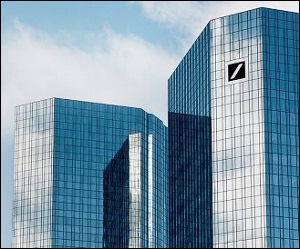Courtesy of Pam Martens
According to press reports around the globe, there’s going to be a hot confab this Sunday by the Board of Deutsche Bank that will focus on the potential to create a so-called “bad bank” to hold some of Deutsche’s toxic assets along with discussions of cutting 15,000 to 20,000 employees from the payroll – meaning as many as one out of every five employees could get the axe. A big part of the job losses will hit Manhattan where Deutsche Bank has a heavy presence on Wall Street — which it plans to severely pare back.
Here’s the short version on why the bank is contemplating these radical moves: Deutsche Bank has reported losses in three of the last four years; its share price has lost 90 percent of its value since February of 2007; as of the close of trading on Wednesday, Deutsche had $16.14 billion in common equity value versus $49 trillion notional (face amount) in derivatives; it’s had four different CEOs in just over four years; it can’t find a merger partner; and its home country of Germany, unlike the “throw money at the Wall Street mega banks” U.S. government, doesn’t seem inclined to hand a life line to Deutsche Bank’s sinking hulk.
To wrap your mind around the concept of a “bad bank,” let’s look at what Citigroup did in January 2009. After turning its former CEO, Sandy Weill, into a billionaire from obscene stock option grants and paying former Treasury Secretary Robert Rubin over $120 million over a decade for a seat on its Board, and other similar drunken sailor compensation sprees, accounting tricks and a toxic derivatives book, Citigroup found itself teetering during the 2008 financial crisis. The U.S. government infused $45 billion in equity capital into its sinking carcass but its share price continued to collapse. Fellow banks on Wall Street refused to lend to it.
So after reporting more giant losses for the fourth quarter of 2008, on January 16, 2009 Citigroup announced it was gathering up all of its toxic assets and shoving them into a “bad bank,” to be called Citi Holdings. The bad bank would also hold the amorphous $301 billion in assets that the U.S. government had agreed to backstop against future losses the prior November.
The day that Citigroup made its bad bank announcement, Friday, January 16, 2009, its stock closed at $3.50 a share. By March, it had lost two-thirds more of its value.
…




